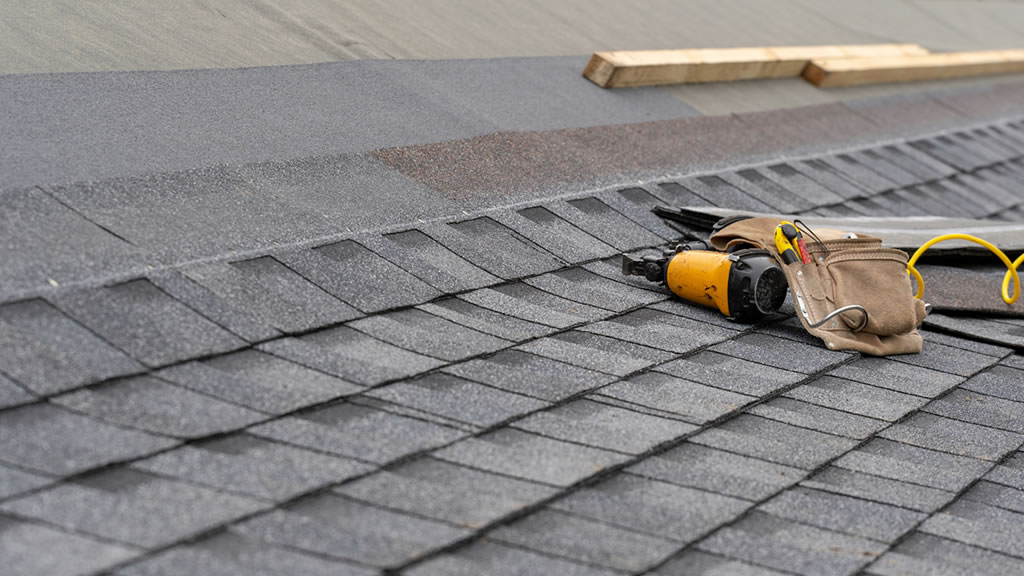Though residential roofs are designed for years of worry-free usage, ordinary wear and tear may lead to the need for roofing repair or replacement. Unfortunately, most of today’s homeowners don’t notice the earliest signs of damage, leading to costly water damage. With an understanding of the symptoms of roof damage, roofing material types, and the cost of a job, it’s easier to make the right choice for the home. In this guide, you’ll find helpful information on making the repair vs. replacement decision and working with local contractors.
Detecting Early Signs of Trouble
With a once-yearly roof inspection, it’s easier to budget and plan for important repairs. Though DIY inspections are possible, it’s best to leave the job to a qualified roofing contractor. They’ll inspect the rooftop for problems such as moss and algae growth, broken flashing, and missing, curled, or cracked shingles. Inside the home, they’ll look for peeling paint, water stains on the ceiling and walls, and other issues that indicate the need for roof repair or replacement.
Repair or Replace: Which Is Better?
The decision to repair or replace a roof depends on various factors, including the roof’s physical condition. Obviously, repairs are more appealing cost-wise, but they’re not always appropriate. If a roof is over two decades old or has suffered extensive damage, repairs may not last that long—and they’ll only delay the inevitable.
Additionally, your area’s climate may help you make the repair vs. replacement decision. For instance, asphalt shingles have a lifespan of up to 20 years, but continuous heat exposure reduces that number significantly. If a roof suffers storm damage, homeowner’s insurance may cover part or all of the cost of repairs or replacement, but it’s your job to mitigate the damage. A roofing contractor can cover the affected area, preventing further water damage and buying enough time to schedule repairs.
Selecting Roofing Materials
Now that you’ve made the decision to replace or repair your roof, the next step is to choose the materials for the job. There are quite a few options available, each with unique pros and cons, and your contractor will recommend materials that fit your aesthetic, durability, and budgetary requirements. Before choosing roofing materials, consider these factors.
- Appearance: A home’s roof is one of its most visible parts, and its appearance has a significant effect on its overall look. When repairing or replacing a roof, be sure that the texture, material, and color is a match for the architectural style of the home.
- The nature of the job: In most cases, new roofs have fewer constraints than repaired roofs do as far as appearance, function, and style are concerned. Repaired areas must be adapted to the type and pitch of the existing roof, and before making the big decision, you’ll have to determine if the results will work with your home. A local roofing contractor can help you make that choice.
- Local codes: Some municipalities require roofing to be of a specific material or grade. Before choosing materials, consult your local code enforcement department to learn about applicable restrictions.
- Cost vs. return: The average replacement roof costs a few thousand dollars depending on the home’s size and the materials’ quality. If you’re planning to resell, opting for costly materials may not make much sense. However, if there are no plans to sell the home, choose the highest quality materials you can afford.
- Energy efficiency: Sometimes known as cool roofing, energy-efficient roofing offers financial and environmental benefits. For instance, it deflects the sun’s energy by reducing the home’s cooling needs.
- The local climate: Some roofing materials, like asphalt shingles, may last for 20 years or longer in cool climates. If they’re used in warmer areas, though, that lifespan decreases significantly.
These are just some of the most important factors to think of when replacing or repairing a roof. Your contractor will help by recommending the right materials for the climate, your home, and your budget.
Material Quality and Quantity: Which Is More Important When Repairing or Replacing a Roof?
As the old saying goes, you get what you pay for. Roofing materials are no exception, and those with lower cost typically have a shorter lifespan than costlier, higher-grade options. When you’re selecting roofing materials, consider their cost and their characteristics. Materials are usually sold by the “square”, or 100 square feet. With that fact in mind, we’ll look at two common roofing materials.
- Asphalt shingles: This is by far the most popular choice for residential roofs. Also known as composition shingles, they’re composed of a mixture of asphalt and cellulose or fiberglass. They’re available in two configurations (composition and architectural laminate). Composition shingles are seen more frequently, aren’t as costly, and last up to two decades. On the other hand, architectural shingles are a big upgrade. They’re made of multiple layers bound by an asphalt-based sealant, and they’re durable, fire-resistant, and may last upwards of 30 years.
Shingles have several notable advantages. They’re easy to install, simple to maintain, and they’re durable when properly maintained. In most instances, they’re economically priced, and they are comparable to costlier roofing materials in terms of longevity and quality. A roofing specialist will review your options as well as their benefits and drawbacks.
Hiring a Roofing Contractor
As a home’s roof is its first line of defense against the elements, it’s crucial to choose an installer with the tools, knowledge, and certifications to get the job done right. Past experience is a major factor; if they’ve done similar jobs in the past, examples will give you a better idea of what to expect.
Time and budgetary constraints are another factor to consider. All projects, including roof repairs and replacements, should start with a firm budget and completion timeline. Choose a contractor who makes promises and sticks to them. The best roofers will work within your parameters, creating a plan that provides the highest-quality results for the lowest possible cost.
Many homeowners are tempted to hire unlicensed roofers as a cost-cutting measure. However, this choice can be disastrous. Roofers should be certified, licensed, bonded, and insured for property damage and on-the-job injuries. If not, you may have to pay for any damages out of pocket, and you might even face a lawsuit.
Though it’s part of human nature to choose the most budget-friendly option, an unusually low bid can be indicative of low-quality workmanship or materials. Expert craftsmanship and top-quality materials may cost more upfront, but they’ll pay off in terms of durability and longevity.
Roofing: The Basics
By learning about the process and understanding industry terminology, you’ll be more able to make informed decisions on repair and replacement. An average-sized roof may take three or four days to install when the crew uses the process outlined below.
- First, the crew will strip the roof of its shingles, depositing them in a roll-away dumpster. Old and damaged drip edging and valley flashing will also be removed. The crew should protect landscaping and use a magnetic tool to remove metal objects from the yard.
- If the roof is in good shape, minor repairs will be made. If it’s in poor condition, the bad sections will be replaced with new sheathing.
- If necessary, ice guard membrane will be installed. It prevents melting ice from getting under the shingles and into the sheathing, where it may cause serious damage.
- Next, the crew will lay asphalt paper over the sheathing, creating an inner moisture barrier. Paper rows are overlapped as they move upward, and they’re usually stapled or tacked into position.
- Metal drip edging is applied on the gable and eave sides.
- New valley flashing is applied where roof planes touch one another. The flashing is typically nailed down and sealed with caulk.
- Tab shingles are applied, beginning at the roof’s eaves and working toward its peak. Where vents are installed, they’re put in as the shingle rows move upward.
- Flashing is installed at penetration points such as chimneys, stack vents, and skylights.
- Ridge vents are installed to help with attic air circulation and prevent ice dams.
As the job concludes, the crew will clean up the area and haul away debris before having the installation evaluated and approved.
Roofing During the Off-Season
A skilled roofing crew is a real asset, and that’s why homeowners everywhere count on contractors to do these jobs. In most parts of the country, “roofing season” spans from spring to fall, but a skilled crew may be able to extend the season slightly. Unless you’re in the midst of a storm, there’s no reason not to hire a contractor during the off-season. In fact, it may even cost less! By hiring a professional roofing team, you’ll get the work done sooner without sacrificing quality.
In Closing
It’s not easy to decide whether to repair or replace a home’s roof, but hopefully, the information in this guide has made the process a little easier. Do your research, ask the important questions, and keep the lines of communication open—you’ll have no trouble finding a dedicated, competent local roofing contractor

